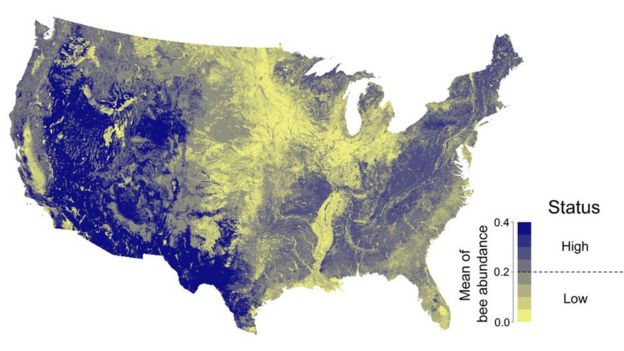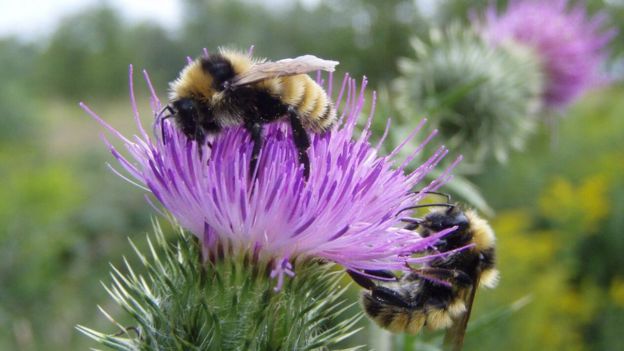
US wild bee numbers decline as land is converted for biofuel
Wild bees in the US have declined in many farming areas according to the first national effort to map their numbers.
The study suggests that between 2008 and 2013, the numbers of wild bees went down across almost a quarter of the US.
The researchers say that the conversion of land to grow corn for biofuels is a key element in the decline.
If the trend continues say the scientists, it could drive up costs and destabilise crop production.
Wild bees play an important role in pollinating many US crops and plants. It's estimated that they contribute around $3bn to the value of agriculture every year.
In 2014, President Obama issued a memorandumcalling for an assessment of the state of honey and wild bees across the US, in the face of an increasing number of threats such as colony collapse disorder.
To map the abundance of wild bees across the country, this model combines a number of databases with expert opinion.
The results show that numbers of wild bees likely declined by 23% between 2008 and 2013 in key agricultural regions in California, the Midwest, in Great Plains states and in the Mississippi river valley.
The study also showed that 39% of US croplands that depend on pollinators are suffering a significant mismatch between the demand for pollination and the supply of bees.
Land for fuel
The most important reason for the decline in numbers according to the authors is the increased demand for biofuels, which has seen more land turned over to growing grains. US law requires that all gasoline sold contains at least 10% ethanol, mostly made from corn.
In the areas that have seen the most serious reduction in wild bees, there have been 200% increases in the amount of corn planted.
 PNAS
PNAS
"The pattern we show is consistent with the expansion of corn for ethanol, the reduction of areas around fields that weren't cultivated before," said senior author, Prof Taylor Ricketts from the University of Vermont.
"They are going back into production and those are the areas that were providing good habitat for wild bees."
While concerns over bee decline in Europe have focussed on the impact of neonicotinoid chemicals on insects of all varieties, this study wasn't able to extract specific information on the use of pesticides.
However the authors are in little doubt that chemicals are having an impact.
"If you look at the maps, the places that show the lowest abundance is essentially a map of intensified agriculture in the US," said Prof Ricketts.
"That's a footprint of agriculture's effect on bees, and its a habitat loss thing and it's also a chemicals and pesticides thing for sure."
The study also highlighted the fact that there is a growing demand for crops that require increased levels of pollination.
Perhaps reflecting changing consumer tastes, demand for pumpkins, blueberries, peaches, apples and watermelons have gone up. Unfortunately the numbers of wild bees available in the areas in which they are grown have declined.
Bees for rent
The researchers believe that the scale of wild bee decline will push farmers to rely even more heavily on commercial honey bee operators who travel across the US, hiring out colonies for pollination.
This is risky, they say, as these operators have suffered devastating losses from disease and colony collapse disorder in recent years.
 Leif Richardson/UVM
Leif Richardson/UVM
The scientists hope that their work will also help regulators to identify the seven million acres that the White House is seeking to protect as pollinator habitat over the next five years.
According to Prof Ricketts, protecting wild bees is not hard to do - but it does require farmers to see the mutual benefits in setting aside habitats for these hard working insects to survive in.
"It's not a big mystery about how to help bees near your farm, they need flowers, they need places to nest and they need to avoid being poisoned by chemicals and we know how to do all those things."
"Often this can be done at very little cost to the farmer because there's marginal lands to do them on. So there's hope for this one."
The research has been published in the journal, Proceedings of the National Academy of Sciences.
No comments:
Post a Comment